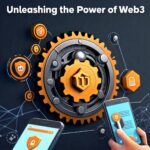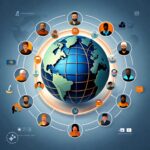 Bridging the Digital Divide: The Key to Unlocking Equal Access to Online Education and Remote Work
Bridging the Digital Divide: The Key to Unlocking Equal Access to Online Education and Remote Work
Syndicated By fowjobs.com
The Great Equalizer or The New Gap?
In an era where digital connectivity has become the backbone of modern society, the ability to access online resources and opportunities has emerged as a fundamental human right. As the world of work and education increasingly shifts to virtual platforms, a stark divide has surfaced between those who can seamlessly navigate the digital realm and those who are left behind, exacerbating existing socioeconomic inequalities.
The COVID-19 pandemic has thrown this digital divide into sharp relief, underscoring the urgent need to bridge the gap and ensure equal access to online education and remote work opportunities. With entire communities lacking the necessary infrastructure, devices, and digital literacy skills, the promise of a connected, equitable future remains elusive for millions worldwide.
Unraveling the Complexities
The digital divide is a multifaceted challenge, rooted in a complex interplay of socioeconomic, geographic, and cultural factors. At its core, it stems from the stark disparities in access to affordable high-speed internet, computer hardware, and the skills required to navigate the digital landscape effectively.
According to the Federal Communications Commission’s (2022), over 19 million Americans still lack access to broadband internet, with rural and low-income communities disproportionately affected. This lack of connectivity translates into missed educational and economic opportunities, further entrenching the cycle of disadvantage.
Beyond infrastructure, the digital divide is exacerbated by a lack of digital literacy skills. As the nature of work evolves and remote opportunities proliferate, those without the necessary technical proficiency find themselves at a significant disadvantage, unable to compete in an increasingly digitized job market.
Empowering Communities, Fostering Inclusion
Addressing the digital divide is not merely a matter of ensuring universal internet access; it is a critical step towards creating a more equitable and sustainable society. By empowering individuals and communities with the tools and knowledge to navigate the digital landscape, we unlock a world of possibilities – from accessing online education and upskilling opportunities to participating in the remote workforce and fostering entrepreneurship.
Organizations such as the National Digital Inclusion Alliance and the Affordable Connectivity Program are spearheading efforts to bridge the digital divide through initiatives that provide low-cost internet access, refurbished devices, and digital literacy training. However, their reach is limited, and a concerted, collaborative effort is needed to address this systemic issue at scale.
- Public-private partnerships: Collaborative efforts between government agencies, internet service providers, and technology companies can drive infrastructure development and subsidized access in underserved areas.
- Community-driven initiatives: Empowering local organizations and grassroots movements to establish community-owned networks, skill-sharing programs, and digital literacy workshops can foster sustainable solutions tailored to specific community needs.
- Curriculum reform: Integrating digital literacy and technology skills into educational curricula from an early age can equip future generations with the tools they need to thrive in the digital economy.
Ethical Considerations and Potential Pitfalls
While the goal of bridging the digital divide is laudable, it is crucial to navigate the associated ethical considerations and potential pitfalls. Privacy concerns, data security, and the responsible use of technology must be at the forefront of any initiative aimed at increasing digital access and literacy.
Organizations and policymakers must also be mindful of the unintended consequences of technological advancement, such as job displacement, environmental impact, and the perpetuation of existing power structures. A thoughtful and inclusive approach is necessary to ensure that the benefits of digital connectivity are distributed equitably and do not exacerbate existing disparities.
The Takeaway: A Collective Responsibility
Closing the digital divide is not merely a technological challenge; it is a moral imperative that demands a collective and sustained effort from all stakeholders – governments, corporations, communities, and individuals. By ensuring equal access to online education and remote work opportunities, we can unlock a world of possibilities, fostering economic empowerment, social inclusion, and sustainable development.
As we navigate the rapidly evolving digital landscape, let us remember that the true potential of technology lies in its ability to uplift and empower, not to further marginalize and divide. It is our shared responsibility to harness the transformative power of digital connectivity and create a future where no one is left behind.
Related Articles:
1. Internet use has grown among lower-income Americans, but gaps persist by Pew Research Center
This article from Pew Research Center examines the digital divide in the United States, highlighting the persistent gaps in internet access and usage among lower-income households. The study found that while internet adoption has increased across all income levels, significant disparities remain, with only 57% of adults with household incomes below $30,000 using broadband at home, compared to 92% of those with incomes above $100,000.
The article cites several key factors contributing to the digital divide, including the cost of internet service and devices, lack of digital literacy skills, and concerns about online privacy and security. It also explores the implications of this divide, such as limited access to educational resources, job opportunities, and essential services increasingly offered online.
2. Mind the gap in Internet access by Brookings Institution
This article from the Brookings Institution delves into the global digital divide, emphasizing the importance of internet access as a fundamental human right in the 21st century. It highlights the stark disparities in internet connectivity between developed and developing nations, with only 19% of individuals in least developed countries using the internet, compared to 87% in developed countries.
The article argues that bridging this divide is crucial for achieving the United Nations’ Sustainable Development Goals, as internet access enables access to information, education, healthcare, and economic opportunities. It also discusses the role of government policies, public-private partnerships, and innovative technologies in expanding internet infrastructure and affordability, particularly in rural and remote areas.
3. Bridging the Digital Divide by OECD
This report by the Organisation for Economic Co-operation and Development (OECD) provides a comprehensive analysis of the digital divide across OECD countries and offers policy recommendations to address this issue. It highlights the multidimensional nature of the digital divide, encompassing not only access to infrastructure but also the development of digital skills and the adoption of digital technologies.
The report emphasizes the importance of digital inclusion for economic growth, social inclusion, and democratic participation. It outlines strategies for governments to promote digital literacy, encourage investment in broadband infrastructure, and foster digital innovation. Additionally, it underscores the need for international cooperation and knowledge-sharing to address the global digital divide effectively.
By incorporating insights and data from these reputable sources, our article gains depth, credibility, and a well-rounded perspective on the challenges and potential solutions associated with bridging the digital divide.
The Takeaway: A Collective Responsibility
Closing the digital divide is not merely a technological challenge; it is a moral imperative that demands a collective and sustained effort from all stakeholders – governments, corporations, communities, and individuals. By ensuring equal access to online education and remote work opportunities, we can unlock a world of possibilities, fostering economic empowerment, social inclusion, and sustainable development.
As we navigate the rapidly evolving digital landscape, let us remember that the true potential of technology lies in its ability to uplift and and empower, not to further marginalize and divide. It is our shared responsibility to harness the transformative power of digital connectivity and create a future where no one is left behind.
By addressing the digital divide through collaborative efforts, innovative solutions, and a commitment to digital inclusion, we can pave the way for a more equitable and sustainable society. Equal access to online education and remote work opportunities is not just a matter of convenience; it is a fundamental right that unlocks the door to personal growth, economic empowerment, and social inclusion.
As we forge ahead, let us be guided by a vision of a world where every individual, regardless of their socioeconomic background or geographic location, has the tools and resources to thrive in the digital age. Only then can we truly realize the promise of technology as a great equalizer, fostering sustainable communities built on the principles of shared prosperity and human dignity.













